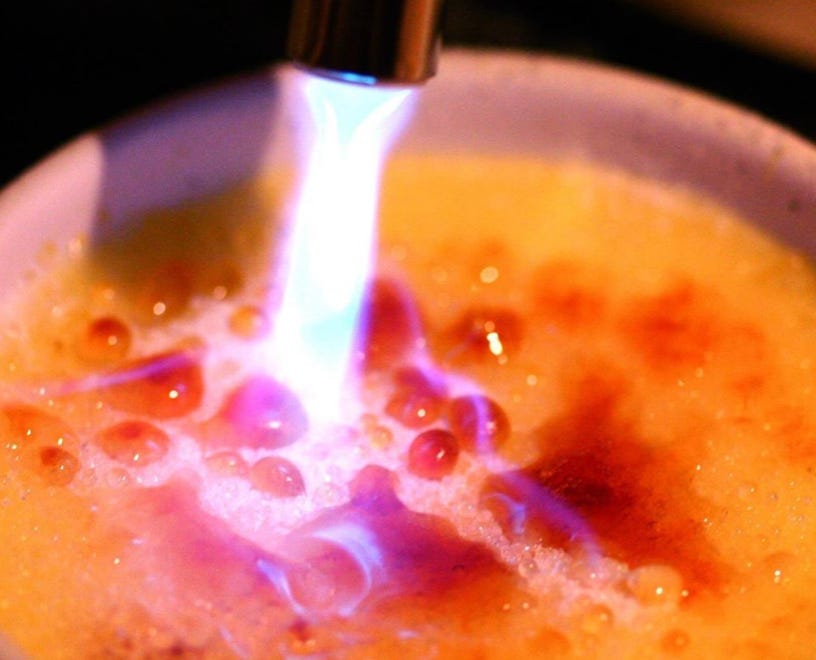There is something about being behind a blowtorch that is making me feel very cheffie. A slight power kick. The sight of flame pouring into the sugar hypnotises, draws me in.
Fire meet Sugar
The blue flame pours into the white sugar.
First the sugar granules pool and form a liquid.
I sweep the flame back and forth and as I do they foam and bubble.
I power the flame straight into the bubbles and watch as they change colour from pale brown, to light gold, to dark …
“Not too much!”
Agata’s voice cuts in and pulls me back from the brink.
It’s Day 10 of the 100 Day Chef Stage and I’m having a blast (literally), helping Agata in the pastry section.
By section, I mean compartment.
The pastry section is actually one-person cubicle, the size of a phone booth.
It’s air-conditioned, and a sliding glass door keeps the kitchen heat out and the cool in. A large cold-box, really for preparing ice-cream, chocolate and all things sweet.
Inside, it’s perfectly organised, neat - just like Agata herself.
I am finishing the torrijas.
Caramelising the sugar, I work the flame back and forth across two trays, building the heat up in layers, so as not to scorch the bread.
Every one in Spain has their own Torrija recipe, and their favourite is always their mum’s version, which goes more or less like this:
Day old bread is soaked in sweetened milk, then coated in beaten egg, fried in oil, sprinkled with sugar, and served with ice-cream.
In other words - Eggy Bread. Pain Perdu, s'il te plait.
Modern chefs are taking it up a level, using almond milk, adding white chocolate, using triple fermented bread or serving it with coconut soup.
Here at El Monastrell, the torrijas have been given a Michelin twist.
Brioche is used instead of day old bread. It is soaked in a creme anglaise instead of milk. And it’s cooked in an oven instead of fried.
Finally it’s sprinkled with sugar, caramelised, and served with confit orange.
It’s as light as you like.
If you’d like the recipe let me know (in the comments or message) and I’ll send it to you. I’m thinking this one might be more popular than the Snails Paella? :-)
Do you need a Blowtorch?
Yes. You absolutely do. Everyone needs a blowtorch in their life. ;-)
If only to caramelise sugar on your new-found torrija recipe a blow torch is a must!
But there are a thousand reasons why a blow torch will come in handy in your kitchen.
Use a blowtorch to sear tuna. Colour meringue. Skin a tomato. Char red pepper. Crisp the skin on sea bass. Burn the hairs off pig’s ears (too much?) Brûlée a crème brûlée. Blast a cheese toastie.
They’re impressive and inexpensive.
Avoid the fancy versions and opt for the no-frills set up they use in professional kitchens where a detachable top is screwed onto a butane canister (like this Marko Blow Torch Butane Gas Kit).
Plus you’ll have a blast!
Blowtorches bring a bit of drama and enjoyment into cooking.
And that’s all good in my books.
Having fun, enjoying your cooking, means the results will be better. Your food will taste better. The enjoyment will shine through.
Nafas is an Arabic word that explains this; nafas is the energy that passes from the cook into the food that makes it extra-delicious. A meal can have nafas.
Isn’t that the truth?
How much better are the meals you cook when you are enjoying the process, than those you cook when you are stressed?
Cooking isn’t always easy, but the game of cooking should always be fun.
Just like training for sports. Most often, training is hard-work, as you push yourself out the door on a cold frosty morning to go for a run, or bike to the top of that steep hill lungs screaming for mercy. But that doesn’t mean you can’t enjoy it.
And if there is enjoyment there is more likelihood of success.
Studies show the higher the enjoyment experienced, the more effort athletes are willing to expend.
And in a nutshell, the more effort you expend the more likely you are to do well.
I digress. Back to the torrijas.
All too soon, I have run out of sugar to caramelise, the torrijas are all a bubbly, golden, caramel, and reluctantly I find myself switching the blowtorch off.
Agata slices the torrijas into perfect rectangles.
As she slices, the crew gather around us, their aprons flapping like vultures.
Soon I find out why.
The shape of the torrijas must be perfect rectangles, which means all those ugly, misshapen off-cuts are chef’s perks.
We cut the last torrija and Agata signals an OK.
At which point the vultures descend to sweep away the left overs.
Want to join me on this journey?
For the next 100 Days I’m staging in Spanish Michelin star restaurants. In the next episode, things get spotless. I learn what they mean by a deep clean.
If you want to join me for the next episode, add your email to the list. It’s free!
The journey so far:









Great recipe, yes please I would love it sent to me. I also have a blowtorch. Enjoying following your journey too. Sue